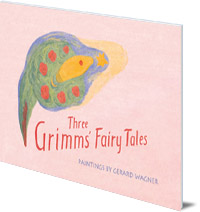Quick Look
A beautiful collection of artwork inspired by Grimm fairy tales. Includes a lecture by Rudolf Steiner on the significance of fairy tales.
Description
Those who have concerned themselves for a long time with restoring to humanity the fairy tales that had been somewhat glossed over by modern civilization—people such as the Brothers Grimm, though they did not adopt a spiritual-scientific view—understandably had the feeling that they were renewing something that belongs intimately to human nature. After an intellectual culture had done its part for centuries to estrange human souls—including children—collections such as those of the Grimm brothers have rightly found their way into the modern human consciousness. They have again become the common heritage of children's souls. As Spiritual Science becomes more than theory and information in human minds, fairy tales will become more and more the underlying mood of human souls, uniting them increasingly with the spiritual roots of those stories.
The illustrations in Three Grimms’ Fairy Tales by the German painter Gerard Wagner for “Briar Rose,” “Jorinde and Joringle,” and “The Star-Taler” represent a unique artistic approach to the illustration of children’s books. Through Wagner’s lifelong investigation into how form can arise from objective color experience, the images are attuned individually in a deep way to the mood of each fairy tale and to children’s essential moral nature and creative fantasy. The book is a finely illustrated children’s book as well as a book of fine art.
Three Grimms’ Fairy Tales also includes an afterword on painting “out of the color” by Peter Stebbing, director of the Arteum Painting School in Dornach, Switzerland, and a lecture by Rudolf Steiner on fairy tales in the light of spiritual investigation.
Author
Peter Stebbing was born in Copenhagen in 1941 and attended Waldorf schools before studying art in Brighton and London. He moved to the U.S. and graduated from Cornell University with an M.F.A. in painting. Following his first teaching stint at the University of Kansas, Peter began teaching color courses at the City University of New York in 1970. Having begun investigations into Goethe’s color theory, he visited the Gerard Wagner painting school in Dornach, Switzerland. There he began training with Wagner, who asked him to teach in the school. Peter later established a painting school at the Threefold Educational Foundation in Spring Valley, New York. For the past thirty years, he has taught introductory courses in Goethe’s color theory with experiments in England, Germany, Switzerland, and the U.S. Since 1992, Peter has been director of the Arteum Painting School in Dornach, Switzerland (www.arteum-malschule.de.vu), and has held a number of exhibitions of his work in Europe and North America.
Gerard Wagner (1906–1999) was born in Germany and grew up in England. He began his vocation as an artist by learning from an English plein air painter before starting formal studies at the Royal College of Art in London. Beginning in 1926, he took up the challenge of a new direction in painting as initiated by Rudolf Steiner, which became the essence of his life’s work for more than seventy years. Through his efforts to grasp the secrets of Steiner’s training sketches for painters, Wagner succeeded in disclosing their metamorphic character and, from this, was able to develop a systematic approach to painting. Elisabeth Wagner-Koch, whom Gerard later married, became his first student in 1950, and together they established The Painting School at the Goetheanum, of which he remained the principle teacher until his death in Arlesheim,Switzerland. Rudolf Steiner’s indications for an art of the future remained the impulse for Wagner’s research and artistic activity throughout his life. The fruits of his research are a unique method of teaching and his archive of paintings, which continue to be a source of inspiration for the school. Wagner’s wife Elisabeth cares for the archive of about 4,000 paintings.

